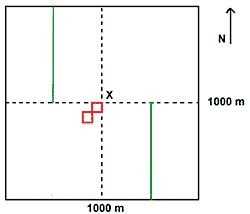Wood decaying polypores in boreal forests of Finland and northwestern Russia - Mariko Lindgren100 hectare study quadrates
In the middle of each study quadrate, a 0.5 hectare study plot - formed of two 0.25 ha subplots - is set up (red). If more than one third of a subplot is covered by open or sparsely forested peatland, the study plot is twisted around x. On the study plot all dead trees more than 5 cm in diameter, living aspens, goat willows and old pines are recorded according to the field instructions for collecting tree-, dead tree- and biotope- data. The occurrences of polypores and some other wood decaying fungi is checked from all dead and living trees according to the field instructions for collecting data on wood decaying fungi on sample plots. On the other parts of the study quadrate polypores are searched by a time-based method. The aim is to cover the 99.5 ha area and find as many of the studied species and occurrences of threatened polypore species as possible. New species and occurrences of threatened species are recorded in intervalls of 30 minutes. In the data sets 1 - 6 six hours were used to survey each study quadrate this way.To sample the dead tree quantity and quality of the whole study quadrate, two 500 meter long sample lines are studied (green). If more than 200 meters of a sample line hit lake or open mire the line is moved 500 meters nort- or southwards. On a 10 wide area along the sample lines all dead trees, living aspens, goat willows and old pines are recorded according to the field instructions for collecting tree-, dead tree- and biotope- data.
|
 1 x 1 km squares - outlined by coordinate lines - form the basis of this field-method. These 100 hectare squares are called study quadrates. The elements of a study quadrate are shown in the figure.
1 x 1 km squares - outlined by coordinate lines - form the basis of this field-method. These 100 hectare squares are called study quadrates. The elements of a study quadrate are shown in the figure.